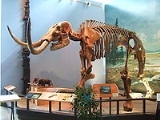
Mastodon
Overview
Extinction
In biology and ecology, extinction is the end of an organism or of a group of organisms , normally a species. The moment of extinction is generally considered to be the death of the last individual of the species, although the capacity to breed and recover may have been lost before this point...
genus
Genus
In biology, a genus is a low-level taxonomic rank used in the biological classification of living and fossil organisms, which is an example of definition by genus and differentia...
Mammut which inhabited Asia
Asia
Asia is the world's largest and most populous continent, located primarily in the eastern and northern hemispheres. It covers 8.7% of the Earth's total surface area and with approximately 3.879 billion people, it hosts 60% of the world's current human population...
, Africa
Africa
Africa is the world's second largest and second most populous continent, after Asia. At about 30.2 million km² including adjacent islands, it covers 6% of the Earth's total surface area and 20.4% of the total land area...
, Europe
Europe
Europe is, by convention, one of the world's seven continents. Comprising the westernmost peninsula of Eurasia, Europe is generally 'divided' from Asia to its east by the watershed divides of the Ural and Caucasus Mountains, the Ural River, the Caspian and Black Seas, and the waterways connecting...
, North America
North America
North America is a continent wholly within the Northern Hemisphere and almost wholly within the Western Hemisphere. It is also considered a northern subcontinent of the Americas...
and Central America
Central America
Central America is the central geographic region of the Americas. It is the southernmost, isthmian portion of the North American continent, which connects with South America on the southeast. When considered part of the unified continental model, it is considered a subcontinent...
from the Oligocene
Oligocene
The Oligocene is a geologic epoch of the Paleogene Period and extends from about 34 million to 23 million years before the present . As with other older geologic periods, the rock beds that define the period are well identified but the exact dates of the start and end of the period are slightly...
through Pleistocene
Pleistocene
The Pleistocene is the epoch from 2,588,000 to 11,700 years BP that spans the world's recent period of repeated glaciations. The name pleistocene is derived from the Greek and ....
, 33.9 mya to 11,000 years ago. The American mastodon
American mastodon
The American mastodon is an extinct North American proboscidean that lived from about 3.7 million years ago until about 10,000 BC. It was the last surviving member of the mastodon family. Fossil finds range from present-day Alaska and New England in the north, to Florida, southern...
is the most recent and best known species of the group. Confusingly, several genera of proboscids from the gomphothere
Gomphothere
Gomphotheriidae is a diverse taxonomic family of extinct elephant-like animals , called gomphotheres. They were widespread in North America during the Miocene and Pliocene epochs, 12-1.6 million years ago. Some lived in parts of Eurasia, Beringia and, following the Great American Interchange,...
family have similar-sounding names (e.g., Stegomastodon
Stegomastodon
Stegomastodon is an extinct genus of gomphothere, a family of proboscideans. It is not to be confused with the genus Mammut from a different proboscidean family, whose members are commonly called "mastodons", nor with the genus Stegodon, from yet another proboscidean sub-family, whose members are...
) but are actually more closely related to elephants
Mammutidae
Mammutidae is a family of extinct proboscideans that lived between the Miocene to the Pleistocene or Holocene. The family was first described in 1922, classifying fossil specimens of the type genus Mammut , and has since been placed in various arrangements of the order...
than to mastodons.
The genus gives its name to the family Mammutidae
Mammutidae
Mammutidae is a family of extinct proboscideans that lived between the Miocene to the Pleistocene or Holocene. The family was first described in 1922, classifying fossil specimens of the type genus Mammut , and has since been placed in various arrangements of the order...
, assigned to the order Proboscidea
Proboscidea
Proboscidea is a taxonomic order containing one living family, Elephantidae, and several extinct families. This order was first described by J. Illiger in 1881 and encompasses the trunked mammals...
.
Unanswered Questions

